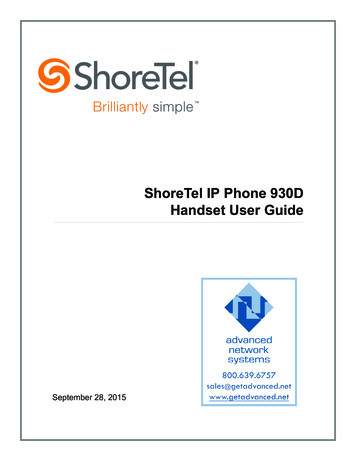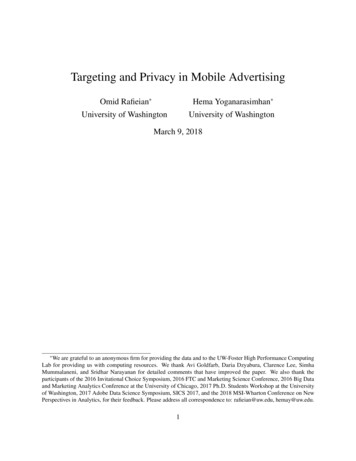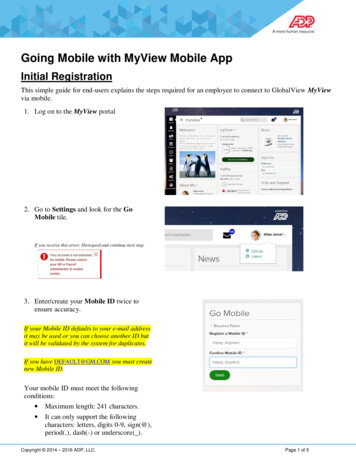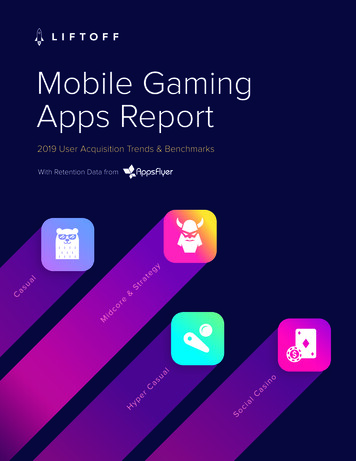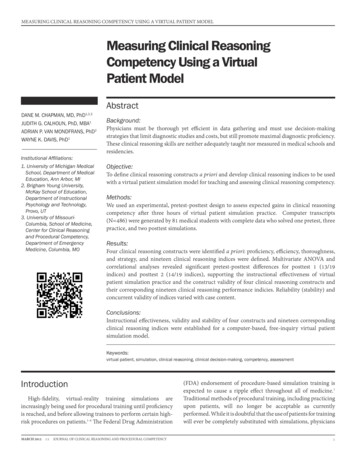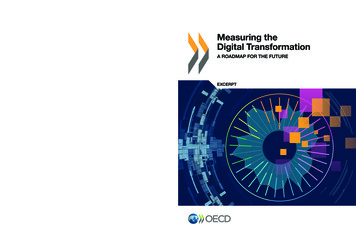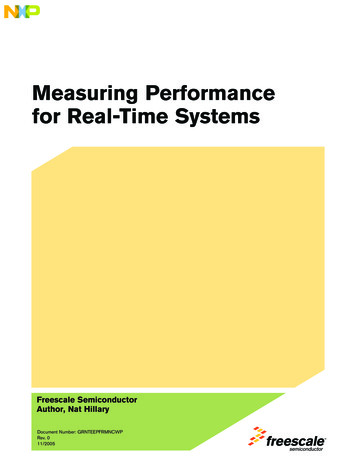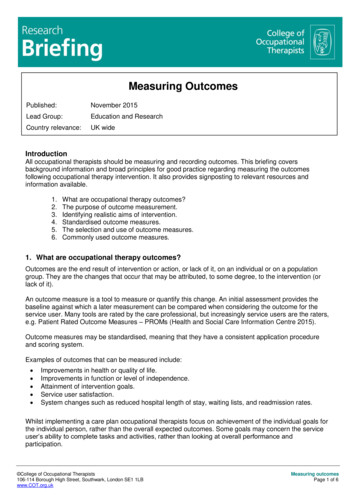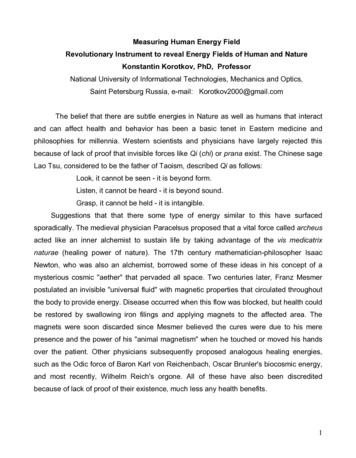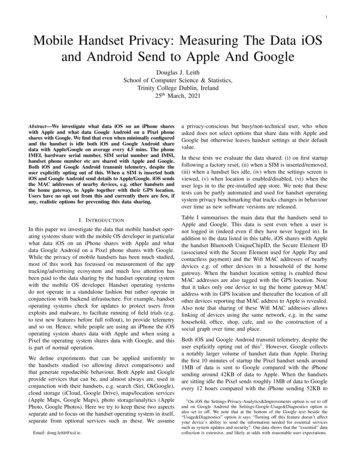
Transcription
1Mobile Handset Privacy: Measuring The Data iOSand Android Send to Apple And GoogleDouglas J. LeithSchool of Computer Science & Statistics,Trinity College Dublin, Ireland25th March, 2021Abstract—We investigate what data iOS on an iPhone shareswith Apple and what data Google Android on a Pixel phoneshares with Google. We find that even when minimally configuredand the handset is idle both iOS and Google Android sharedata with Apple/Google on average every 4.5 mins. The phoneIMEI, hardware serial number, SIM serial number and IMSI,handset phone number etc are shared with Apple and Google.Both iOS and Google Android transmit telemetry, despite theuser explicitly opting out of this. When a SIM is inserted bothiOS and Google Android send details to Apple/Google. iOS sendsthe MAC addresses of nearby devices, e.g. other handsets andthe home gateway, to Apple together with their GPS location.Users have no opt out from this and currently there are few, ifany, realistic options for preventing this data sharing.I. I NTRODUCTIONIn this paper we investigate the data that mobile handset operating systems share with the mobile OS developer in particularwhat data iOS on an iPhone shares with Apple and whatdata Google Android on a Pixel phone shares with Google.While the privacy of mobile handsets has been much studied,most of this work has focussed on measurement of the apptracking/advertising ecosystem and much less attention hasbeen paid to the data sharing by the handset operating systemwith the mobile OS developer. Handset operating systemsdo not operate in a standalone fashion but rather operate inconjunction with backend infrastucture. For example, handsetoperating systems check for updates to protect users fromexploits and malware, to faciltate running of field trials (e.g.to test new features before full rollout), to provide telemetryand so on. Hence, while people are using an iPhone the iOSoperating system shares data with Apple and when using aPixel the operating system shares data with Google, and thisis part of normal operation.We define experiments that can be applied uniformly tothe handsets studied (so allowing direct comparisons) andthat generate repoducible behaviour. Both Apple and Googleprovide services that can be, and almost always are, used inconjunction with their handsets, e.g. search (Siri, OkGoogle),cloud storage (iCloud, Google Drive), maps/location services(Apple Maps, Google Maps), photo storage/analytics (ApplePhoto, Google Photos). Here we try to keep these two aspectsseparate and to focus on the handset operating system in itself,separate from optional services such as these. We assumeEmail: doug.leith@tcd.ie.a privacy-conscious but busy/non-technical user, who whenasked does not select options that share data with Apple andGoogle but otherwise leaves handset settings at their defaultvalue.In these tests we evaluate the data shared: (i) on first startupfollowing a factory reset, (ii) when a SIM is inserted/removed,(iii) when a handset lies idle, (iv) when the settings screen isviewed, (v) when location is enabled/disabled, (vi) when theuser logs in to the pre-installed app store. We note that thesetests can be partly automated and used for handset operatingsystem privacy benchmarking that tracks changes in behaviourover time as new software versions are released.Table I summarises the main data that the handsets send toApple and Google. This data is sent even when a user isnot logged in (indeed even if they have never logged in). Inaddition to the data listed in this table, iOS shares with Applethe handset Bluetooth UniqueChipID, the Secure Element ID(associated with the Secure Element used for Apple Pay andcontactless payment) and the Wifi MAC addresses of nearbydevices e.g. of other devices in a household of the homegateway. When the handset location setting is enabled theseMAC addresses are also tagged with the GPS location. Notethat it takes only one device to tag the home gateway MACaddress with its GPS location and thereafter the location of allother devices reporting that MAC address to Apple is revealed.Also note that sharing of these Wifi MAC addresses allowslinking of devices using the same network, e.g. in the samehousehold, office, shop, cafe, and so the construction of asocial graph over time and place.Both iOS and Google Android transmit telemetry, despite theuser explicitly opting out of this1 . However, Google collectsa notably larger volume of handset data than Apple. Duringthe first 10 minutes of startup the Pixel handset sends around1MB of data is sent to Google compared with the iPhonesending around 42KB of data to Apple. When the handsetsare sitting idle the Pixel sends roughly 1MB of data to Googleevery 12 hours compared with the iPhone sending 52KB to1 On iOS the Settings-Privacy-Analytics&Improvements option is set to offand on Google Android the Settings-Google-Usage&Diagnostics option isalso set to off. We note that at the bottom of the Google text beside the“Usage&Diagnostics” option it says “Turning off this feature doesn’t affectyour device’s ability to send the information needed for essential servicessuch as system updates and security”. Our data shows that the “essential” datacollection is extensive, and likely at odds with reasonable user expectations.
2IMEIApple umber!!PhonenumberDevice IDsLocationTelemetryCookiesLocal IPAddress!!UDID, Ad IDAndroid ID,RDID/Ad ID,Droidguardkey!%!!!!!%Device WifiMACaddress%!NearbyWifi MACaddresses!%TABLE IS UMMARY OF HANDSET DATA SHARED WITH A PPLE AND G OOGLE WHEN USER IS NOT LOGGED IN .Apple i.e., Google collects around 20 times more handset datathan Apple. In 2020 it is estimated that in the US there are113M iPhone users2 and 129M Android users3 . Assuming allof the Android users have Google Play Services enabled thenscaling up our measurements suggests that in the US aloneApple collects around 5.8GB of handset data every 12 hourswhile Google collects around 1.3TB of handset data. Whenthe handset is idle the average time between iOS connectionsto Apple is 264 seconds, while Google Android connectsto Google on average every 255 seconds i.e. both operatingsystems connect to their back-end servers on average every4.5 minutes even when the handset is not being used.With both iOS and Google Android inserting a SIM into thehandset generates connections that share the SIM details withApple/Google. Simply browsing the handset settings screengenerates multiple network connections to Apple/Google.A number of the pre-installed apps/services are also observedto make network connections, despite never having beenopened or used. In particular, on iOS these include Siri, Safariand iCloud and on Google Android these include the Youtubeapp, Chrome, Google Docs, Safetyhub, Google Messaging, theClock and the Google Searchbar.The collection of so much data by Apple and Google raises atleast two major concerns. Firstly, this device data can be fairlyreadily linked to other data sources, e.g. once a user logs in (asthey must to use the pre-installed app store) then this devicedata gets linked to their personal details (name, email, creditcard etc) and so potentially to other devices owned the user,shopping purchases, web browsing history and so on. Thisis not a hypothetical concern since both Apple and Googleoperate payment services, supply popular web browsers andbenefit commercially from advertising. Secondly, every time ahandset connects with a back-end server it necessarily revealsthe handset IP address, which is a rough proxy for location.The high frequency of network connections made by both iOSand Google Android (on average every 4.5 minutes) thereforepotentially allow tracking by Apple and Google of devicelocation over time.With regard to mitigations, of course users also have the optionof choosing to use handsets running mobile OSs other thaniOS and Google Android, e.g. /e/OS Android4 . But if they2 3 t-of-andrioid-users-in-the-us/4 https://e.foundation.choose to use an iPhone then they appear to have no optionsto prevent the data sharing that we observe, i.e. they are notable to opt out. If they choose to use a Pixel phone then it ispossible to startup the handset with the network connectiondisabled (so preventing data sharing), then to disable thevarious Google components (especially Google Play Services,Google Play store and the Youtube app) before enablinga network connection. In our tests this prevented the vastmajority of the data sharing with Google, although of course itmeans that apps must be installed via an alternative store andcannot depend upon Google Play Services (we note that manypopular apps are observed to complain if Google Play Servicesis disabled). However, further testing across a wider range ofhandsets and configurations is needed to confirm the viabillityof this potential mitigation. When Google Play Services and/orthe Google Play store are used then this mitigation is notfeasible and the data sharing with Google that we observethen appears to be unavoidable.A. Ethical DisclosureThe mobile OS’s studied here are deployed and in activeuse. Measurements of Google Play Services backend trafficwere previously disclosed in [5], but the present study isbroader in scope. We informed Apple and Google of ourfindings and delayed publication to allow them to respond.To date Apple have responded only with silence (we sentthree emails to Apple’s Director of User Privacy, who declinedeven to acknowlege receipt of an email, and also posted aninformation request at the Apple Privacy Enquiries contactpage at apple.com/privacy/contact but have had no response).Google responded with a number of comments and clarifications, which we have incorporated into this report. They alsosay that they intend to publish public documentation on thetelemetry data that they collect. A key consideration is whatmitigations are possible, and on what time scale can they bedeployed. It seems likely that any changes to Apple iOS orGoogle Android, even if they were agreed upon, will take aconsiderable time to deploy and keeping handset users in thedark for a long open-ended period seems incorrect.II. R ELATED W ORKThe privacy and security of mobile handsets has been thesubject of a substantial literature, e.g. see [8], [9] and references therein. However, there has been little work reportingon the traffic between handset operating systems and theirassociated backend servers. Probably closest to the presentwork is the recent analysis of the data that web browsersshare with their backend servers [4] and of the data shared
3by Google Play Services [5]. The latter is motivated by Covidcontact tracing apps based on the Google-Apple ExposureNotification (GAEN) system, which on Android require thatGoogle Play Services be enabled. The present work is broaderin scope, but also motivated in part by this since the datashared by Apple iPhones running Covid contact tracing appsremains largely unknown. The measurements that we reporthere indicate that on an iPhone running a covid contact tracingapp the data collection by Apple iOS is remarkably similar tothat by Google Play Services on Android phones and usersappear to have no option to disable this data collection byiOS.To the best of our knowledge there has been no previoussystematic work reporting measurements of the content ofmessages sent between iOS and its associated backend servers.Fig. 1. Measurement setup. The mobile handset is configured to access theinternet using a WiFi access point hosted on a laptop, use of cellular/mobiledata is disabled. The laptop also has a wired internet connection. When an appon the handset starts a new network connection the laptop pretends to be thedestination server so that it can decrypt the traffic. It then creates an onwardconnection to the actual target server and acts as an intermediary relayingrequests and their replies between the handset app and the target server whilelogging the traffic.identifying data does each operating system directly send toits backend servers and (ii) Does the data that each operatingsystem transmits to backend servers potentially allow trackingof the IP address of the app instance over time.III. T HREAT M ODEL : W HAT D O W E M EAN B Y P RIVACY ?It is important to note that transmission of user data to backendservers is not intrinsically a privacy intrusion. For example, itcan be useful to share details of the user device model/versionand the locale/country of the device and this carries fewprivacy risks if this data is common to many users sincethe data itself cannot then be easily linked back to a specificuser [11], [6].Issues arise, however, when data can be tied to a specificuser, especially over extended durations and old/new devicepairs. There are at least two main ways that this can occur.Firstly, when a user logs in, as they must to use the preinstalled app store, then this device data gets linked to theirpersonal details (name, email, credit card etc). Secondly, everytime a handset connects with a back-end server it necessarilyreveals the handset IP address which acts as a rough proxyfor user location via existing geoIP services. Many studieshave shown that location data linked over time can be usedto de-anonymise, e.g. see [7], [10] and later studies. This isunsurprising since, for example, knowledge of the work andhome locations of a user can be inferred from such locationdata (based on where the user mostly spends time duringthe day and evening), and when combined with other datathis information can quickly become quite revealing [10].Pertinent factors here are (i) the presence of identifiers withintransmitted messages that allow them to be linked togetherand (ii) the frequency with which messages are sent e.g.observing an IP address/proxy location onc
Trinity College Dublin, Ireland 25th March, 2021 Abstract—We investigate what data iOS on an iPhone shares with Apple and what data Google Android on a Pixel phone shares with Google. We find that even when minimally configured and the handset is idle both iOS and Google Android share data with Apple/Google on average every 4.5 mins. The phone IMEI, hardware serial number, SIM serial .
